
Following impulse noise removal, the next important step in reducing the noise of a used 78 is trying to even out the frequency responses and distortions so that less noise escapes the continuous noise filter in the next step. This can be broken down into several simple steps:
- Low Pass Filter - to remove unwanted high frequency signals at the upper end of the spectrum.
- Parametric Equalisation - to reproduce the correct frequency balance of the recording.
- High Pass Filter - to remove rumble from the recording.

This is the simplest form of noise reduction. In very general terms the maximum theoretical frequency that can be recorded to and obtained from a 78rpm record is somewhere between 8-12kHz as determined by the stylus size and record composition. Earlier recordings will fall well short of this and may not even achieve frequencies above 4kHz. However, this does not mean that all frequencies above these theoretical "cut-off" points should be removed because this is psycho-acoustically unpleasing for physiological reasons. Although there may be no statistical measurable frequencies present, residual background noise is important in perceived fidelity even if that "fidelity" does not actually exist. So in removing these frequencies altogether, whilst we may not have technically lost any information from the original recording, perceptually we have!
Instead, it is better to choose a frequency somewhere around the theoretical value and provide a gentle roll-off of those frequencies above that contain no actual information other than random noise:

ACO G15710 (Fox trot) - The Ohio Novelty Band
| Process | Result |
| Original "Flat" Recording | mp3 |
| 4kHz Brickwall Filter | mp3 |
| 8kHz Low Pass (6dB/Octave) | mp3 |
| 10kHz Low Pass (18dB/Octave) | mp3 |

In the above picture I have used the spectral gain control to enhance the visibility of the instrumental frequencies in the above ACO acoustical recording. As you can see, there is very little in the way of instrumental frequencies above 4kHz if at all just random noise. However, if we completely remove those frequencies as in the example sound file using the 4kHz brick wall filter, the perceived fidelity of the recording is changed significantly. I recommend using a 10-12kHz roll-off. If using 10kHz then @6dB/octave or 18dB if using 12kHz. You may even choose to implement both!

The advantage of using a "Flat" phono-preamplifier is that you can do this step digitally and most restoration software will provide you with various tools to apply the best/correct equalisation. Whilst it is best to do this by ear there are several handy charts available that work well for common label 78s:
- Equalisation Chart 1
- Equalisation Chart 2 (from Rod Elliot's Multi Standard 78 RPM Equaliser)
If unsure, a 250Hz rollover (bass boost) 78rpm equalisation curve often works well for most electrically recorded 78s. Acoustical 78s shouldn't require any equalisation but may benefit from a gentle boost in the lower frequencies.

Parlophone A7402 Ten Million Kisses - The Organ The Dance Band and Me
| Process | Result |
| Original "Flat" Recording | mp3 |
| 250Hz Turnover | mp3 |
| 350Hz Turnover | mp3 |
| 500Hz Turnover | mp3 |
When done, you should really remove any unwanted low frequencies. If not picky, then just run a steep high-pass filter set to 50Hz or so for electric recordings or 100Hz (or more) for acoustical recordings. Again, use your judgment on what frequencies exist or not. If in doubt - check the spectral window or spectrum analyser.
